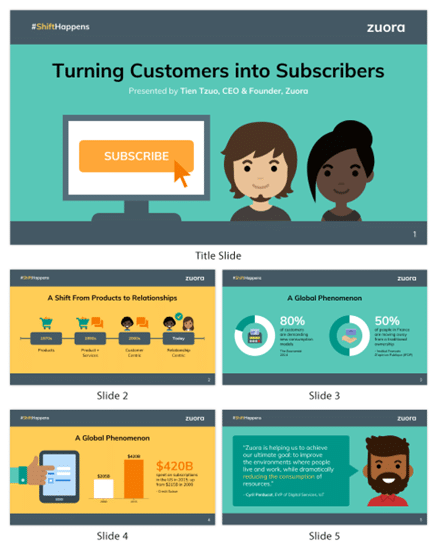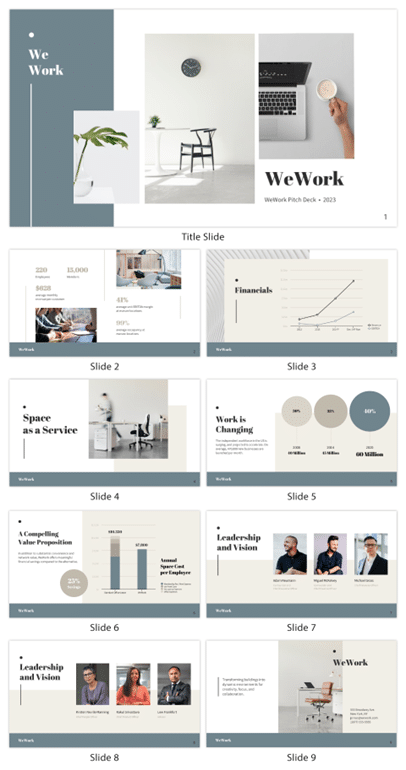Everyone is vying for a potential customer’s attention in the age of information overload. A sales deck can be a critical part of winning a deal and you want to make sure that your document doesn’t backfire on you. Like anything else in life, if you bore people with your presentation, chances are they won’t remember much about what you said or if they do, it will be something that you don’t care to hear (e.g., “You’re presentation was a bit confusing.”). So how can you avoid this? How can your deck keep prospects interested and engaged throughout the entire meeting? I’ve seen several decks come across my desk over the past year and here are seven things to remember:
1) Include helpful charts and graphs in your sales pitch deck
In a world of infographics, it makes sense that charts and graphs are kings. Sharing the relevant data in your deck is important but it’s also a good idea to add a few visual aids that are easy to understand to drive home some of the key points you’re trying to make. You can do this even without complex or expensive software.

2) Your sales pitch presentation ties back to business problems/goals/objectives
Every element of your deck should tie back into the core business objectives that you’re hoping to achieve by using your product or service. In other words, everything on that document should help move the conversation toward a close at the end of your meeting(s). This is another reason why charts and graphs are helpful they can effectively get the point across without having to say much.
3) Do not include jargon in your sales decks
Jargon is a huge pet peeve of mine and it’s one that I see repeated over and over again in sales decks. You don’t need to use hard-to-understand terms just to impress your prospect, this might even turn them off. Your prospective clients, the people who will be using your product or service on a day-to-day basis, should be able to read your deck from start to finish without experiencing some sort of confusion. In other words, if you were to hand this document off to your prospect after your meeting, would they have a hard time understanding it? If yes, then simplify the language until there aren’t any questions left.
4) Include opportunities for feedback/questions in your product pitch presentation
Just because you’re presenting a deck during your meeting doesn’t mean that you’re in control of the conversation. On the contrary, it’s important to create an open dialogue with your prospect where everyone is engaged and participating during each step of your meeting.
One way to achieve this is by ending each slide with a question for your prospect or inviting them to give feedback during certain sections when appropriate. This is also helpful if they ask something at the end of the meeting because you’ll already have everything documented within your deck so you don’t have to scramble around looking for answers.

5) Don’t make your presentation too long
I tell people all the time that just because I’m in marketing, it doesn’t mean that I want to sit through a rambling presentation about every single feature of your product (or I will be dozing off). Sales decks are much the same way. Chances are, your prospect already knows about your company and they’ve probably read through your website/brochure so there’s no need to walk them through every single detail of what you offer. Instead, you can use this meeting as an opportunity to tell stories that showcase how other customers have benefited from using your product or service. Assess each part of your deck, put yourself in your prospect’s shoes and ask yourself if it’s something that would convince you to buy this product or service. If it doesn’t, then you might need to cut that part out.
6) Not too short either
On the flip side, just because I’m in marketing doesn’t mean that I have all day to sit through a sales pitch full of ambiguity and fluff talk. Sales decks are designed to get to the point quickly while still providing potential leads with enough information so they can make an informed decision. Don’t overload your prospects with information, but don’t leave them with little information to go on either. If you’re able to get your whole sales deck presentation across with relevant and clear points within 10 slides, that’s even better.
7) Your sales pitch PowerPoint should include a call to action
Every single slide should have a specific purpose so there’s very little room for ambiguity at the end of the meeting. What I mean by this is simple: what do you want your prospect to do after they’ve finished checking out your deck? Are you hoping to schedule a follow-up call or send over a few more details via email? Either way, it’s important to be clear about what will happen next to keep them engaged and eager to take the next step with your business. Of course, the entire sales process takes time and effort but when it comes to sales decks, it’s important to ensure they’re meeting your goals.
In Conclusion
A memorable sales deck can make the difference between getting a closed deal and losing the opportunity. By using creative visuals, infographics, data visualizations, relatable language, opportunities for discussions, and storytelling in your pitch, you can help your ideas stick in your customers’ minds. And the best part is that there are many tools out there to help you create beautiful and professional presentations without spending hours in design software. Venngage is one such tool that offers a wide range of templates and easy-to-use drag-and-drop features to help you quickly create stunning visuals for your next sales meeting. Make your best sales deck with Venngage today!
